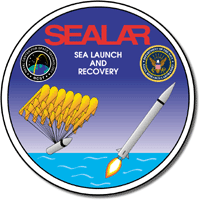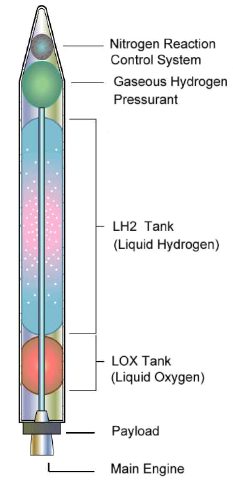|
.. |
|
|
Sea Launch and Recovery .
The Naval Research Laboratory's concept exploration program to demonstrate sea launch and recovery of a rocket. Praxis provided program planning and control, graphics and presentation support, hardware and software technical documentation development, networks scheduling, and launch site support. Praxis was responsible for a number of high level briefings to U.S. Navy and Congressional staff to support the development of the Cooperative Research and Development Agreement signed between the Naval Research Laboratory and the SEALAR corporation.
Note: Praxis is the company that made the Clementine Satellite for the DoD/Navy Mission |
|
|
..
Sea-launched orbital launch vehicle.
The Aquarius Concept was launch of low-cost supplies on a low-cost vehicle. These would be low-cost, easily-replaced consumables such as water, fuel, food, and air as needed by the International Space Station and military spacecraft. Launch failures would be acceptable since the intrinsic value of the replaceable consumables was low. About one-third of the launches were expected to fail SOURCE: Astronautix |
|
| SEALAR (Sea Launched Rocket)
Captain Robert C. Truax (USN) built his first rocket as a teenager in Alameda, California, after reading in Popular Mechanics about Robert Goddard’s work. While at the United States Naval Academy in 1936, he began experimenting with liquid-fueled rocket engines and developed several small experimental models that burned a combination of compressed air and gasoline. During the early 1940s, Captain Truax initiated a program to develop a jet-assisted takeoff (JATO) for the PBY-2 Catalina. He and Dr. Robert Goddard, who was under contract with BuAer, worked side by side for approximately a year on different JATO designs. During the late 1940s, he organized the US Naval Missile Test Center’s propulsion laboratory at Point Mugu, California, and headed rocket development within BuAer. He also conceived and organized the US Naval Rocket Test Center at Lake Denmark, New Jersey. By 1955, however, his proposal for a submarine-launched ballistic missile had failed to win Navy approval. After retiring from active duty in June 1959, Captain Truax headed Aerojet General Corporation’s Advanced Developments Division in Sacramento, California. He formed Truax Engineering, Inc., in 1966 and participated in several important space and missile-related efforts during the late 1960s: a recoverable launch vehicle study, sponsored by the American Institute of Aeronautics and Astronautics (1966); the STRAT-X study of future ballistic missile problems, sponsored by the Institute for Defense Analysis (1966-1967); and troubleshooter for TRW Corporation on the Minuteman ICBM program (1967-1968). An ardent proponent of low-cost access to space since the 1950s, Captain Truax designed a series of amphibious launchers from Sea Dragon in the 1960s to Excalibur and SEALAR (Sea Launched Rocket) in the 1990s. The SEALAR (Sea Eagle) was a mobile SEA LAunched Rocket supported by Navy Research lab funding. Estimated cost $10 M/launch. The projected first launch data was 1996, dependent upon NRL funding, with a suborbital test planned. The amended budget request for FY1992 included $2.5 million to continue development of a low-cost, reusable space booster that would be launched and recovered at sea. The Navy was attempting to develop this sea-launched and recovery (SEALAR ) program with mostly private capital under a cooperative research and development agreement (CREDA), consistent with the intent of the Federal Technology Transfer Act of 1986. The Senate amendment authorized $17.5 million on the basis that SEALAR is a promising approach to solving serious launch problems, including high cost, lack of flexibility, and poor responsiveness. Because of concern that the Navy will not be able to attract enough private capital to develop the system without a tangible government commitment, the Senate amendment authorized additional funding and require that the Navy commit to launch a specific payload on the booster if SEALAR is successfully tested. The conferees recommend the requested amount. The clear intent of the legislation authorizing U.S. government organizations to enter into Cooperative Research and Development Agreement (CRDAs) is to promote expeditious technology transfer from the federal government to other government entities as well as commercial ventures. However, it is not the intent of the legislation to permit middle level department officials to commit an entire department to a program which could have significant policy, program, and budget implications without proper oversight by senior policy officials or the Congress. The November 18, 1991 DoD conference report agreed with the Senate recommendation for Office of the Secretary of Defense review and decision about SEALAR and the proposed CRDA. The conferees further direct that OSD submit by January 30, 1992, the report requested by the Senate. The conferees also direct that any SEALAR CRDA contain the clear stipulation that any such agreement does not require or imply that at any point: (a) the U.S. government will use SEALAR during or after the completion of its development; (b) appropriated funds will be available to support the project directly or indirectly; or (c) U.S. government facilities will be available for use by commercial firms after completion of the development effort. Should the development effort be successful, this guidance does not preclude the Department from considering the purchase of launch services from SEALAR to the extent that there is a requirement for such services, that it could be provided on a cost competitive basis, and that the necessary Congressional authorization and appropriation are provided. As with the earlier Truax projects, it did not achieve flight test status. SOURCE: Global Security |
|
| FAIR USE NOTICE: This page contains copyrighted material the use of which has not been specifically authorized by the copyright owner. Pegasus Research Consortium distributes this material without profit to those who have expressed a prior interest in receiving the included information for research and educational purposes. We believe this constitutes a fair use of any such copyrighted material as provided for in 17 U.S.C § 107. If you wish to use copyrighted material from this site for purposes of your own that go beyond fair use, you must obtain permission from the copyright owner. | |
|
|


